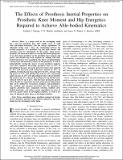The Effects of Prosthesis Inertial Properties on Prosthetic Knee Moment and Hip Energetics Required to Achieve Able-bodied Kinematics
Author(s)
Narang, Yashraj Shyam; Winter, Amos; Arelekatti, Venkata N. M.
Download2015_ATKNee_TNSRE.pdf (5.095Mb)
OPEN_ACCESS_POLICY
Open Access Policy
Creative Commons Attribution-Noncommercial-Share Alike
Terms of use
Metadata
Show full item recordAbstract
There is a major need in the developing world for a low-cost prosthetic knee that enables users to walk with able-bodied kinematics and low energy expenditure. To efficiently design such a knee, the relationship between the inertial properties of a prosthetic leg and joint kinetics and energetics must be determined. In this paper, using inverse dynamics, the theoretical effects of varying the inertial properties of an above-knee prosthesis on the prosthetic knee moment, hip power, and absolute hip work required for walking with ablebodied kinematics were quantified. The effects of independently varying mass and moment of inertia of the prosthesis, as well as independently varying the masses of each prosthesis segment, were also compared. Decreasing prosthesis mass to 25% of physiological leg mass increased peak late-stance knee moment by 43% and decreased peak swing knee moment by 76%. In addition, it reduced peak stance hip power by 26%, average swing hip power by 76%, and absolute hip work by 22%. Decreasing upper leg mass to 25% of its physiological value reduced absolute hip work by just 2%, whereas decreasing lower leg and foot mass reduced work by up to 22%, with foot mass having the greater effect. Results are reported in the form of parametric illustrations that can be utilized by researchers, designers, and prosthetists. The methods and outcomes presented have the potential to improve prosthetic knee component selection, facilitate ablebodied kinematics, and reduce energy expenditure for users of low-cost, passive knees in developing countries, as well as for users of advanced active knees in developed countries.
Date issued
2015-07Department
Massachusetts Institute of Technology. Department of Mechanical EngineeringJournal
IEEE Transactions on Neural Systems and Rehabilitation Engineering
Publisher
Institute of Electrical and Electronics Engineers (IEEE)
Citation
Narang, Yashraj, Venkata Narayana Murthy Arelekatti, and Amos Winter. “The Effects of Prosthesis Inertial Properties on Prosthetic Knee Moment and Hip Energetics Required to Achieve Able-Bodied Kinematics.” IEEE Transactions on Neural Systems and Rehabilitation Engineering (2015): 1–1.
Version: Author's final manuscript
ISSN
1534-4320
1558-0210